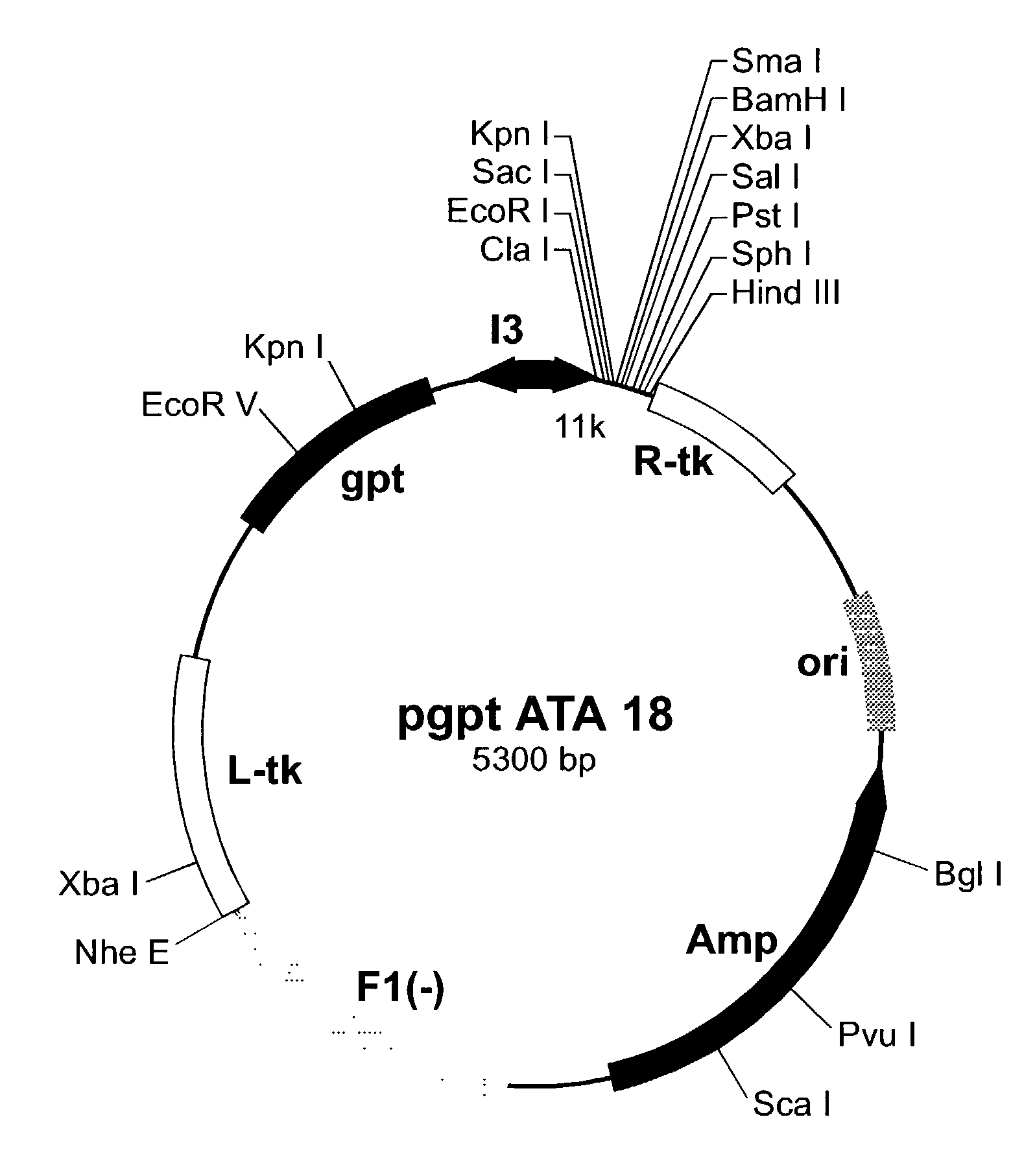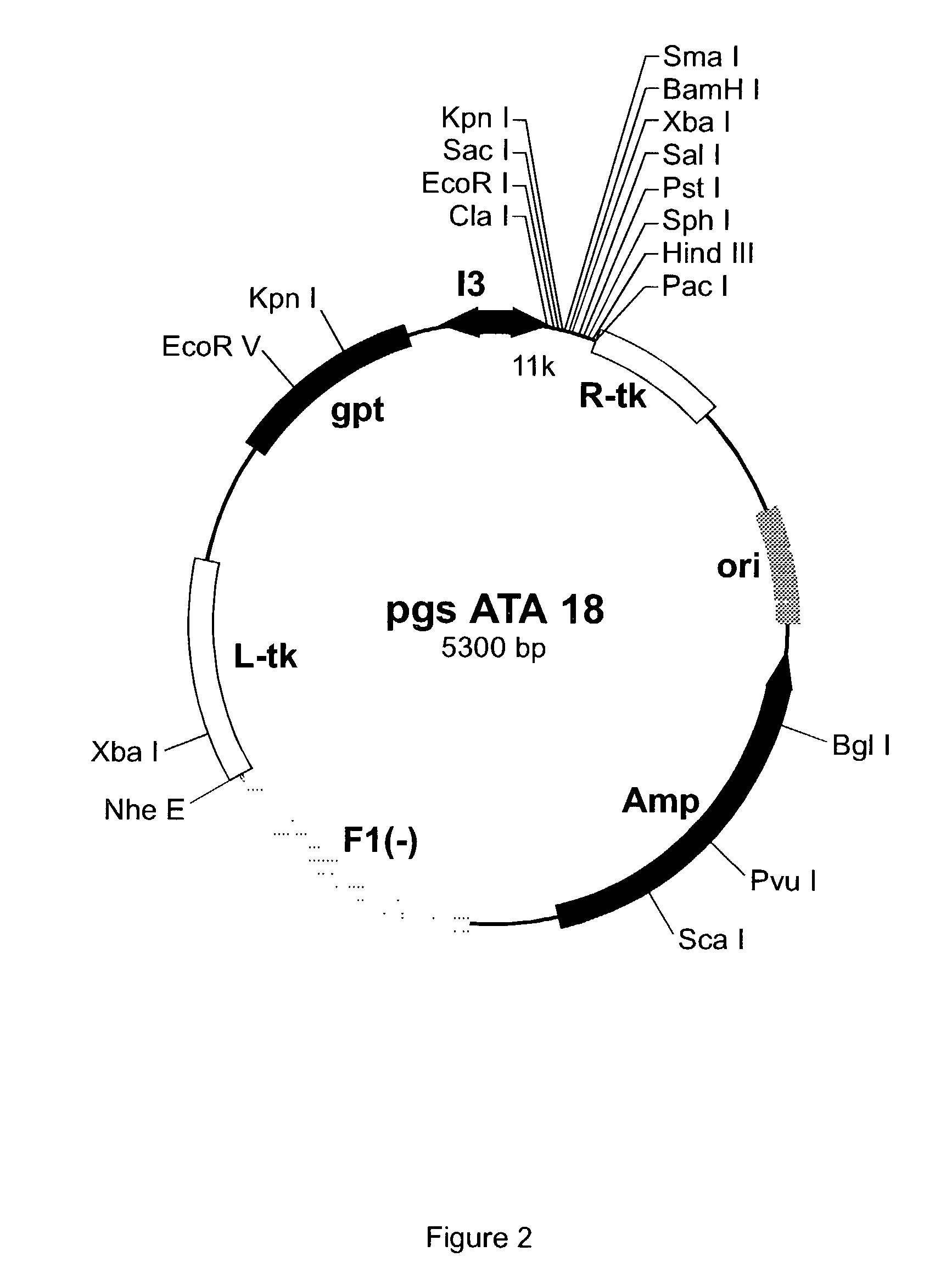Purified hepatitis C virus envelope proteins for diagnostic and therapeutic use
a technology of hepatitis c virus and envelope protein, which is applied in the field of purification of recombinant proteins, synthetic peptides, peptides, etc., can solve the problems of much more expensive manufacturing of hbsag from mammalian cells compared with yeast-derived hepatitis b vaccines
- Summary
- Abstract
- Description
- Claims
- Application Information
AI Technical Summary
Benefits of technology
Problems solved by technology
Method used
Image
Examples
example 1
Cloning and Expression of the Hepatitis C Virus E1 Protein
1. Construction of Vaccinia Virus Recombination Vectors
[0401]The pgptATA18 vaccinia recombination plasmid is a modified version of pATA18 (Stunnenberg et al, 1988) with an additional insertion containing the E. coli xanthine guanine phosphoribosyl transferase gene under the control of the vaccinia virus 13 intermediate promoter (FIG. 1). The plasmid pgsATA18 was constructed by inserting an oligonucleotide linker with SEQ ID NO 1 / 94, containing stop codons in the three reading frames, into the Pst I and HindIII-cut pATA18 vector. This created an extra Pac I restriction site (FIG. 2). The original HindIII site was not restored.
[0402]
Oligonucleotide linker with SEQ ID NO 1 / 94:5′ G GCACGC AAGCTT AATTAATT 3′3′ ACGTC CGTACG TTCGAA TTAATTAA TCGA 5′ {overscore (PstI )} {overscore (SphI )}H{overscore (indIII)} {overscore ( Pac I ()}H{overscore (indI)}II)
[0403]In order to facilitate rapid and efficient purification...
example 2
Construction of HCV Recombinant Plasmids
2.1 Constructs Encoding Different Forms of the E1 Protein
[0405]Polymerase Chain Reaction (PCR) products were derived from the serum samples by RNA preparations and subsequent reverse-transcription and PCR as described previously (Stuyver et al., 1993b). Table 1 shows the feature of the respective clones and the primers used for amplification. The PCR fragments were cloned into the Sma I-cut pSP72 (Promega) plasmids. The following clones were selected for insertion into vaccinia recombination vectors: HCCl9A (SEQ ID NO 3), HCCl10A (SEQ ID NO 5), HCCl11A (SEQ ID NO 7), HCCl12A (SEQ ID NO 9), HCCl13A (SEQ ID NO 11), HCCl17A (SEQ ID NO 13), as depicted in FIG. 21. cDNA fragments containing the E1-coding regions were cleaved by EcoRI and HindIII restriction from the respective pSP72 plasmids and inserted into the EcoRI / HindIII-cut pgptATA-18 vaccinia recombination vector (described in example 1), downstream of the 11K vaccinia virus late promoter. ...
example 3
Infection of Cells with Recombinant Vaccinia Viruses
[0411]A confluent monolayer of RK13 cells was infected of a m.o.i. of 3 with the recombinant HCV-vaccinia viruses as described in example 2. For infection the cell monolayer was washed twice with phosphate-buffered saline pH 7.4 (PBS) and the recombinant vaccinia virus stock was diluted in MEM medium. Two hundred μl of the virus solution was added per 106 cells such that the m.o.i was 3, and incubated for 45 min at 24° C. The virus solution was aspirated and 2 ml of complete growth medium (see example 2) was added per 106 cells. The cells were incubated for 24 hr at 37° C. during which expression of the HCV proteins took place.
PUM
| Property | Measurement | Unit |
|---|---|---|
| molecular weight | aaaaa | aaaaa |
| molecular weight | aaaaa | aaaaa |
| pH | aaaaa | aaaaa |
Abstract
Description
Claims
Application Information
 Login to View More
Login to View More - R&D
- Intellectual Property
- Life Sciences
- Materials
- Tech Scout
- Unparalleled Data Quality
- Higher Quality Content
- 60% Fewer Hallucinations
Browse by: Latest US Patents, China's latest patents, Technical Efficacy Thesaurus, Application Domain, Technology Topic, Popular Technical Reports.
© 2025 PatSnap. All rights reserved.Legal|Privacy policy|Modern Slavery Act Transparency Statement|Sitemap|About US| Contact US: help@patsnap.com



